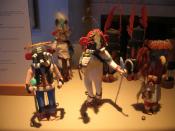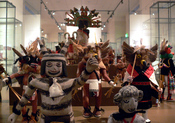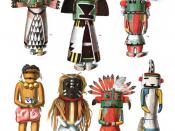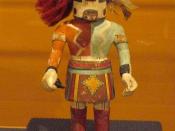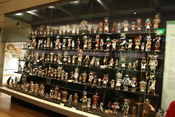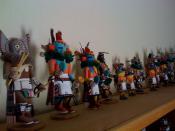Native Americans have inhabited this country for many generations. We see so many things that are influenced by the Native Americans and we find ourselves in awe of the independence of these peoples and the culture that they have come from.
When we look at art through the eyes of the Native American we should see a functional and usable art. Art was not for aesthetic reasons; it had real purpose. The folk art that came from these cultures were for religious and moral reasons. Everything that these people had had a necessity in their group. The Kachina is one of these necessities.
The Kachinas were and still are an important part of the religion of the Pueblo Indians, but I will focus on Hopi Indians. The Kachinas were friendly spirits much like our Christian Saints; however there were some evil Kachinas that punish those who disobey Hopi law.
The Kachinas play an important role in the various religious ceremonies, many of which take the form of dances and chants. When a Hopi man dresses himself in the costume of a particular Kachina, he believes the spirit of that Kachina has replaced his personal identity. The ceremonies ask the Kachinas to bring plentiful crops, or give the people of the village good health and luck.
Hopi children believe in Kachinas just as American children believe in Santa Clause. In the ceremonies, the children aren't supposed to recognize their fathers, uncles or friends who are taking the role of the Kachinas. And as Santa brings gifts to children, certain Kachinas bring Kachina dolls, fruits, sweets, and other surprises. Kachina dolls are given to the children not as toys, but as something to be treasured and studied so that they may become familiar with the various spirits that are an important part of their religion.
The phenomena of Kachina are relatively new. The religion of the Hopi has not always been in place. As we know, religion is put into place to keep order with in a group or tribe. It sets the standard of how the group is supposed to live. In order to look more closely at the Kachina, we will look at the history of the Hopi Indian.
In the book, The Art of Hopi Carvers, we are told that the Hopi's main ancestors were the Anasazi, a group of people who at about the time of Christ came to depend on agriculture. They were located in the area of the Four Corners, Utah, Colorado, New Mexico, and Arizona. They lived in underground houses called pit houses. "By A.D. 700 they had built houses above ground in adjacent clusters, which over time developed into the typical pueblo structure. (1)". In these structures were built a large number of kivas. A kiva is "an underground ceremonial room which are believed to provide entry from and to the Underworld" (2). "Each Kiva has a symbolic representation of the Sipaapu, the hole to the underworld from which the Hopi believed they came and the pathway to the upper spirit word, the symbol of emergence in Hopi belief. As in the modern Hopi kivas, the prehistoric structures had a fireplace or stove with a heat deflector, benches along the kiva walls, and niches for ritual objects. Then as now, the entrance to the kiva was by a ladder through the roof." (3).
No evidence of the Katsina religion would be found until about the thirteenth and fourteenth century. Archaeological finds state that Katsina most likely came from Mexico and this was because of a great drought in the south. During this drought many tribes moved north. With the sudden population boom, there became a necessity for law, thus comes the religion. "Religion provided the matrix for this cohesion, and the Katsina religion involved every man, woman, and child. Even today every Hopi is initiated into the Katsina religion, thus uniting members of different clans and religious societies. One of the major characteristics of Hopi society is that individualism is de-emphasized; the interest of the community is always placed before that of the individual. The Katsina religion has a great deal to do with this attitude; men spend days preparing for the ceremonies in the seclusion of the kiva, while women prepare food for the ceremonies to feed the Kasinam and other villagers. Women also weave baskets and make pottery as gifts for the Kasinam, as all faming activities are pursued only with there blessings. The Katsina religion has permeated Hopi life ever since it gained prominence in the fourteenth century and has provided the unity that has given the Hopi the strength to overcome great obstacles." (4).
One of the first reports of the Hopi religion came in 1681from a Spanish lieutenant general of cavalry, Juan Dominguez de Mendoza. "In his report he stated that he entered the deserted pueblo of Puaray in early December of that year and found many masks de cacherias, in imitation of the devil, which are those they use in their diabolical dances. The Spanish burned all of them." (5).
According the Encyclopedia Encarta, there are over 200 kachinas, including ancestral and nature spirits and variety of gods. The art comes into play with the representations of the Kachinas. Masks are one way that the presence of the Kachina comes. The other way is with kachina dolls. The masks are treated with great respect and are treated to reverence and secrecy. "The Pueblo believe that in ancient times the kachinas lived on earth but were sent to live in thee bottom f the great desert lake and left their masks behind. At firs6t, the kachinas themselves returned from time to time to dance for the people, but after the dance a member of the community always died, or left with the Kachina. Finally agreeing to come no more, the kachinas authorized dancers to take over their ritual roles" (6). The dancer who wears the mask believe that the god, spirit, or relative actually takes over their bodies and helps them to guide their people whether they are doing rain ceremonies, punishing those who are misbehaving, or giving gifts. The kachina masks are made of leather or of wood. They are decorated with bright paints and dyes and adorned with beads, feathers, and other decorations. They usually have a large nose or beak.
"When not using them in ceremony, the Pueblo keep the masks hidden, especially from young children, who are told that the kachinas they have seen in rituals are genuine spirits that will punish them for misbehavior. Only later is the secret of the kachinas masks revealed to the children in a solemn initiation rite." (7).
The kachina dolls are fashioned after the masks. They are usually made of cottonwood, or cactus root, and painted or dyed with bright colors, and adorned with beads and feathers. Originally the dolls were made as gifts for infant girls, because girls cannot partake in the mask ceremonies, by there maternal uncles. They are to be used for religious training and will continue to receive the dolls until she becomes of age. (The significance of the maternal uncle giving the doll is because the Hopi were a matriarchal society. Daughters stayed in their family's homes when they married).
The dolls and masks are generally carved out of a single piece of wood. It must be a living tree that was used to make the item. Many hours were spent making these items because they were important to the symbolism of their religion. They did not worship the icons, but they had much reverence.
Today the tradition of the kachina dolls and masks continues. There are many collectors of these items. A Hopi kachina doll can go easily for $1000 to start. The reason that these go for so much is that the Hopi is thought to be the ultimate kachina craftsman. They are considered the best at their craft. Because of the waterfowl and predatory bird preservation acts, the kachinas are not as they used to be. Also, if you are not a Hopi Indian with ties to the religion, you cannot get an authentic kachina doll or mask. The colors are different. Each color is important to the Hopi and symbolizes something sacred, such as the sky, water, etc. They do not use the same colors and symbols for their retail work.
SOURCES Kiva Trading Company. Internet. 1997, Kiva Corporation, Cold Spring Harbor, New York. www.kivatradin.com/kachina.htm Britannica.com. Internet. 2000, Britannica.com, Inc.
www.britannica.com The Art of Hopi Carvers. Internet. 1998, University of Arizona Press.
www.uapress.arizona.edu/samples/sam471.htm Kachina. Internet. 1998, L7Group@infomagic.com.
www.indiantraders.com/aboutart/kachinas/kachcult.htm Katsina Dolls. Internet. www.nativeamericantraders.com/kachina.htm
